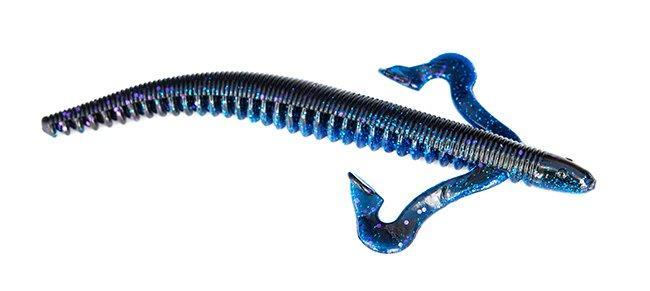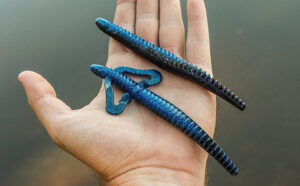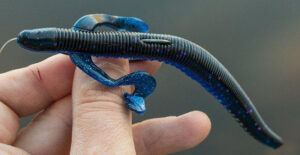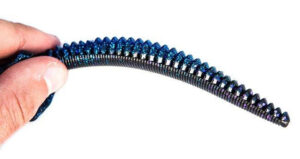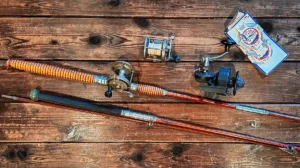For whatever reason, the bass fishing has been ridiculously tough in my area for the last several weeks. The fish are scattered and when you finally find a few, they’re tough to trick into biting. Such unsually lethargic fall behavior has, however, opened my eyes to the effectiveness of the Gene Larew Salt Flick’R. I figured its subtle profile and multiple rigging options might lead to a few extra bites and that has certainly been the case lately.
In my opinion, there are 3 things worth noting about this bait.
- Versatile
- Durable
- Color selection
Lots of rigging options
I’ve always been somewhat of a sucker for versatile soft plastic baits. Whenever I can help it, I make a concerted effort to keep my tackle as simple and streamlined as possible— so when I find one bait that can do multiple things in several different scenarios, I’m naturally intrigued.
With that being said, the Gene Larew Salt Flick’R has proven to be a very versatile bait that has been a joy to use. I’m even tempted to call it a “fun” bait because if you’re not getting bites, there are a lot of quick little modifications you can make in order to change its profile and presentation.
- Texas rig— I’m often a proponent of pegging my Texas rigs, but I’ve found the trick with the Salt Flick’R is to use it with an unpegged weight. The weight hits the bottom long before the bait does, so the Salt Flick’R essentially “chases” the weight throughout the retrieve. Each time it falls, its legs kick wildly which has resulted in a lot of bites occuring on the initial descent. I’ll pitch this rig to vertical cover such as dock posts and grass with some excellent success.
- Weightless Texas rig— I’ve spent a lot of time fishing the Salt Flick’R on a weightless Texas rig and I’ve been very impressed by it. This bait is heavier than most stick worms I’ve used and I actually really like it. Because it falls faster, I’m able to fish long stretches of cover more efficiently. Not to mention, its weight has also allowed me to fish deeper docks with a weightless approach— something I have previously avoided. I don’ t have the patience to wait 15 seconds for a lightweight stick worm to fall beside a deep dock post.
- Wacky rig— This setup doesn’t look very pretty, to be honest. But there have been a couple of days it has been surprisingly productive. You see a lot of guys jamming nail weights into their wacky worms, which is totally fine, but I’d rather not fool with it if I don’t have to. The little legs of the Salt Flick’R actually cause the bait to glide at an angle to the bottom. You’ll notice the “leg-end” of the Salt Flick’R falling a bit slower than the smooth end, which results in a very unique fall. It’s a pretty big worm to be wacky rigging, but if you know you’re around big ones, it’s definitely something worth trying.
- Shaky head— Don’t be afraid to throw this dude on a shaky head and chunk it at some of your favorite deep brush piles. Its legs aren’t really big enough to obstruct its fall through cover, so I’ve experienced very few hang-ups when fishing it this way. And again, due to its weight, it falls quickly through the branches and limbs so I’ve been able to get away with using a much smaller head size that I normally would.
When the fishing is really tough and I’m having trouble getting bites on the Salt Flick’R, I’ve actually had a lot of success by ripping the legs off and fishing it like a traditional stick worm. Although this results in a very slender, streamlined profile, the ribbed body of the Salt Flick’R displaces a lot of water with the slightest twitch of your rod tip which has resulted in a lot of fish catches in really dirty water.
Excellent durability
One of my favorite characteristics of the Salt Flick’R is its durability and elasticity. You can stretch this bait to twice its body length without any ripping or tearing whatsoever, which really comes in handy whether you’re skipping docks or getting a lot of bites. It hasn’t been uncommon for me to catch 5 or 6 bass on a single Salt Flick’R.
This bait also holds a hook very well. A lot of stick worms fly off the hook and tear after repetitive skipping or a few fish jumps, but the Salt Flick’R stays on the hook without any problems. I don’t find myself constantly re-rigging or fooling with the bait— it’s very hassle-free regardless of the application.
Great color selections
You’ll find the Salt Flick’R in 18 really good-looking colors. Some soft plastics manufacturers might have more color options, but Gene Larew seems to have spent a lot of time developing the “right” colors. They’re not too crazy or flashy, but after browsing their color selections you’ll notice a lot of very practical options that work well in every water color imaginable.
I tend to pay a lot of attention to color consistency in soft plastics because, especially in clear water, small deviations in color can make a really big difference. Each Salt Flick’R in a particular color looks exactly the same, so I haven’t had to dig through my bags to find the right color combination for certain situation. I’m able to blindly grab one, rig it up and keep fishing.
I’ve found the Gene Larew Salt Flick’R to be a very practical and versatile soft plastic for both shallow and deep water bass fishing applications. If you’re looking to experiment with something a little different, I certainly recommend check it out.
The Gene Larew Salt Flick’R is available at TackleWarehouse.com.


